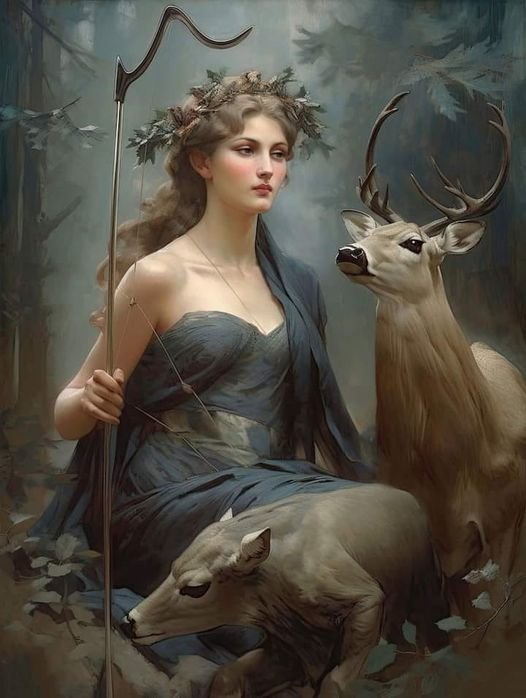by Aziz Ali Dad
In the mythical cosmology of Gilgit, Murkum is, perhaps, the most prominent deity among the deities. The names, characteristics and rituals associated with female deities have been almost forgotten in Gilgit. However, Murkum is an exception as she remains alive in the collective cultural memory and the remnants of ideas and rituals associated with her. Women believe that she is the one who favours the birth of a child. Overall, she appears to be the deity of pristine nature.
During the 1955 German expedition, renowned archaeologist and anthropologist Karl Jettmar visited Haramosh and Gor villages of Gilgit District. He discovered megalith structures erected in honour of deity Murkum and the god Taibaan. Even today, people vividly recall the existence of Murkum, especially hunters, who still believe in her as the deity of the hunt. Women, on the other hand, associate her with childbirth, seeing her as a divine figure who favours them during the process. Overall, Murkum is perceived as the deity of untamed nature.

Painting: Artemis Diana, the goddess of nature, childbirth, wildlife, healing, and the hunt in Greek Mythology.
The ritual for hunting is a very elaborate affair in Gilgit. From the details of hunting rituals, it appears that all the activities are geared to purify oneself from anything that smacks or smell of humans. It is only by undoing of human element with him, the hunter can get the favour of Murkum deity for his hunt. For example, the hunter purifies himself by incensing his body with juniper smoke. It takes away foul smell of human body. Then he leaves early in the morning so that no humans can see him. If he comes across with human on his way to hunting, then he cannot hunt as Murkum gets across with him because he contains human image in his eyes. To see the creatures of sacred nature, including ibex, the hunter has to purify his eyes and soul. Eyes are the reflection of soul. If eyes are dominated from human perspective than the soul cannot experience and converse with sacred being of deities. Hunters report that before the hunting, their hunting equipment makes clinking noise at night. It is an indication that Murkum is conversing with the tools. In their dreams, she informs the hunters about location and the ibex they are going to hunt. There are anecdotes where she accompanies them on the hunt and speaks to them while remaining invisible.
Murkum’s melodious voice and ethereal beauty enchant those who happened to see her. The hunters carry out the journey of hunt in the state of trance. It appears that it is not they, but Murkum who is responsible for their actions. It is an indication of total merger of one’s consciousness and soul to the sacred order of nature. Only by becoming part of the nature, the natural beings reveal and speak to the humans. Under the influence of Murkum’s enchantment, the hunter even understands the language in which ibexes converse with one another. That is why, he is remains all ears to the conversation taking place between the ibexes in a herd. The hunter remains very careful not to hunt at random. Rather he focuses on the ibex which is old and without kids. The popular dialogic folk song between an ibex doe and her kid basically denotes the ability of humans to comprehend the language of wildlife. It is possible if the humans keep them pure to merge themselves completely in the natural order.
Also, the deity Murkum favours women giving childbirth. It is said that a child is as innocent as the newly born kid of ibex. An ibex’s kid remains innocent throughout his/her life and never defile nature as her/his soul and body remain in complete harmony with the nature, but in the case of humans, the kid child become loses his innocence as he matures and becomes threat to his group as well as source of contamination in the nature. Because of the power of the woman to give birth to an innocent being from the contaminated human, Murkum sees this attribute of the woman akin to the heavenly quality of deity than human beings. It is Murkum who sows the seed of child in woman’s womb. After the birth of a child, Murkum also takes care of her/him. In the cultural practices of Gilgit, a mother is strictly prohibited to leave her newly born baby alone because the ugly mythical creature like Yacholo and Yamalo, want to abduct him/her so that they can rear the child till adulthood and then make her/him sexual partner of a young Yachaini. Our of the copulation of human with uncanny creature of Yachaini, they hope to get a beautiful offspring. It is said that the creature Yacholos avoid becoming visible to human beings because they are ashamed of their ugly looks. That is why is they always remain in search of beautiful newborn boys and girls.
Sometimes Murkum appears in the dream or hallucination during the period of birth pangs of woman and speaks to her about the destiny of the would-be child. There are oral anecdotes where the mother of a child is told beforehand that she would give birth to female or male child. At times, Murkum decides about the future of child. For example, she decides whether the boy will get tie to nuptial knot or not. Murkum warns the mother to enjoin his would-be son not to marry a human because it has been decided already by Murkum that he would get married to a fairy. There are many folks and hunting tales in Gilgit-Baltistan that narrates the fate of a child who grew extremely handsome as he matured and became magnet for the damsels in the valley. Taking the undue advantage of his attractiveness, the young lad won hearts of many girls and fell in love with some. Upon the consummation of love or getting married to a girl of his liking, Murkum deity got enraged and exacted punishment by luring him into an enchanting meadow or cliff overlooking the valley and threw him off the mountain.
So, the boy with future tidings and blessings of Murkum has to be treated as a special child as he is supposed to spend his time till adulthood and during adulthood in observing certain taboos, performing certain practices, following norms and chores that are not observed by a normal child in human society. Hence, such a person is deemed to be endowed with mythical qualities. Only by transcending human limitation one can become mythical. That is why he is destined to give birth to mythical or beautiful creatures in the heavenly meadows of fairyland. Normally, looks mythical child are extremely beautiful. A look at his or her face mesmerises people. That is why Murkum keeps an eye on the child till he or she wean away from drinking the milk of her/his mother. It is a normal observance in the homes of Gilgit that a child sometime mimic of drinking milk while asleep. The child’s family does not awake the child when s/he mimics because they deem that it is the time when Murkum deity is feeding her or him with her own milk.
Murkum does not take care of male children only. She is equally interested in gorgeous baby girls. However, unlike boys reaching to their adulthood, in the case of girls, Murkum does not wait till the girls attain their maturity. Murkum takes the selected girl away when before she reaches the adolescence. It is deemed that the life in the domain under Murkum and her house is that of eternal youth and freshness. Its inhabitants never grow old. So, the girls in fairyland look as fresh as flower and young when they are 100 years old. The famous mythical tale of Hini village in Hunza about “Bano Shaari Sashkin Tay Gae – Shari Ban has gone to the fairyland” narrates the story of a child who went to a garden to fetch milk from the goat. While on her way back after milking the goat, Shari Bano was taken away to heavenly abode on the order of Murkum. Her parents searched for her in every nook and corner of the valley but failed to find her. Ultimately, they gave up their search thinking that she might be kidnapped by a Yacholo whose world is impossible to penetrate for humans.
Two years after Shari Bano’s disappearance, a famous Shaman from another valley happens to visit Hini to get the famed wine of the village. He is said to have 280 guardian fairies with wide outreach in heavenly domain of fairyland. The father of Shari Bano had the best wine well in the village. He requested the shaman to find the whereabout of their beloved child and bring her back. He will be rewarded with 6 wineskins of fine wine. After performing some shamanistic rituals, he communes with Murkum and sang a song about the blissful life of Shari Bano in fairyland. At the same time, he communicates to Murkum about her parents’ state especially mother whose tears dried and blood drops from her eyes whenever she cries. Thereupon, Murkum relents and allows Shari Bano to visit her parents and ask for special arrangements on a particular day to welcome her on the beats of music. On the day of her arrival, the villagers gather in a particular spot and Shari Bano descends from the heaven flanked by fairies fluttering of whose wings were creating a soothing music and mingling with the beats of musicians on the ground. Shari Bano’s parent finds that in the freezing winter, she came with a bouquet of flower and milk in the same pot when she disappeared. The milk was warm as if it has just been freshly milked it from the goat. After hugging and kissing their child, the parents ask, “Whence you bring flower and warm milk in the freezing winter?” “Where I come from nothing rots or turn rancid” says Shari Bano and continues, “There is eternal spring season in the fairyland. I plucked these flowers besides my window when I started my journey to the village.” There are many interpretative dimensions to this story. However, the point here is to show the eternity and freshness of fairyland and world of deity against the decay of human life in the world.
Murkum rules is not limited to meadows and snow but also to the depths of the mountains as he knows the secrets and wealth hidden in the bowels of earth. Since she has an easy access to precious stone, her throne in the crystal palace of snow is laden with “Muk” which means ruby in Shina and Brushashki languages. During my field work, several shamans informed me that they not only know the inner recesses of human heart and mind but also depths of the land and mountains because Murkum repose trust in their purity and confides these secret locations of precious stones.
From all the signs and symbolism, it appears that Murkum sits on the top of the hierarchy of deities in local cosmology inhabited by both real and mythical entities. In the local parlance, different names are attributed to Murkum. These are Daraniji, Raachi Payaanli, Mushgoon, Lailigi, and sometimes witch etc. However, these are either attributes of Murkum or different states induced by her. Daraniji is a generic term that is attributed to beings and creature that are external to humans. It may be that if Dar in the word Daraniji refers to dur which means hypnotism because one of the attributes of Murkum is that under the influence of her sigh a person gets hypnotised and hand over his actions and personality to her or her subordinate guardian fairies. When a person suffers from somnambulism, s/he is said to be under the influence of dur or hypnotism of Murkum. There are many anecdotes that narrates events where a person gets up from his bed at night and start climbing the mountain to reach into the upper meadows and heavenly abode of fairies in the snow.
It may be possible that these attributes later diverged from Murkum and evolved into minor deities in the cosmology but still functioning under the overarching deity of Murkum. For example, Musghoon is a deity that preside over the hunt. In case of a successful hunt, she become subordinate to the hunter to help him performing the task of hunting. Similarly, Raachi Payaanli is a deity that takes care of wildlife. In Shina and Brushashki language, Rach means to protect and take care. So, the fairy of Raachi Payaanli takes care of hunters and shepherds. She also performs the task of informing shaman about the impending natural disaster in an area.

Aziz Ali Dad is a social thinker. He holds a master’s in philosophy of social science from the London School of Economics and Political Science. He writes columns on social and intellectual topics in ‘The News’, ‘The Friday Times’, ‘Hum Sub’, ‘The High Asia Herald’ and ‘Baam-e-Jahan’. He has published numerous articles and research papers on philosophy, culture, politics, and literature in national and international journals. Aziz has been a research fellow at the Crossroads Asia and Asia Leadership Programme in Japan and at the Modern Oriental Institute in Berlin, Germany.

The High Asia Herald is a member of High Asia Media Group — a window to High Asia and Central Asia


One thought on “Murkum: the Deity of Pristine Nature”
Karl Jetmaar’s has mentioned Murkum in his book “Beyond The Gorges” which is correct. Murkum was worshiped by local people at village Guray Haramosh before Islam .it’s symptoms are still still found .All people of the village after bathing and wearing clean cloths assembled before Murkum and pray for the safety of thier lives and good luck.